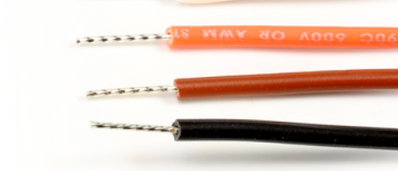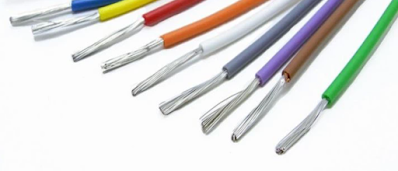22AWG and 24AWG are what most pedal builders use, but depending on where you live, these values may not be readily available from your local store. Of course, online is always an option, but shipping a bunch of heavy copper reels can be expensive.
22AWG and 24AWG are not available in the most common electronics stores in Australia (Jaycar and Altronics). 21AWG and 26AWG are the nearest available size stocked locally.
WHAT SIZE HOOK-UP WIRE TO USE FOR PEDALS?
As mentioned above, 22AWG or 24AWG are your best bet. Anything larger than stranded 21AWG will probably not fit in a standard vero board. Also, keep in mind the size of the lugs on a 3PDT switch and the DC jack that are quite small.
Thinner than 26AWG starts to feel a bit sketchy - not recommended. As the wire gets smaller, I find it harder to solder and it feels like it will break off. Specs for voltage and current start to get a bit on the low side too.
Note the sizes below, which are limiting factors.
Standard vero:
- ~1mm holes (0.9mm)
- 2.54mm pitch (0.1 of an inch)
Vintage style vero:
- 1.4mm holes
- 3.8mm pitch (0.15 of an inch)
Now this will vary a little, but as a reference, Alpha 3DPT have 2.3mm x 1.1mm holes. I have seen some specs for 0.9mm wide holes.
AMERICAN WIRE GAUGE (AWG) SIZES
AWG sizes specifically relate to solid core wire - the equivalent stranded wire will be slightly larger. Wire thickness decreases as the AWG number increases.
21AWG
- 0.723mm in diameter
- 0.412mm square in area
21AWG can take more current / voltage than any pedal will ever need. This is often sold as medium-duty general use hookup wire (available at Altronics). This gauge is getting into amp building territory.
22AWG
- 0.644mm in diameter
- 0.326mm² in area
24AWG
- 0.511mm in diameter
- 0.205mm² in area
26AWG
- 0.44mm in diameter
- 0.129mm² in area
26AWG is often sold as light-duty hookup wire. It’s still quite OK to use considering the low voltage and amperage requirements of your average guitar pedal. Not my favourite - I think it’s a bit fragile.
If you’re in Australia, this is one of the options on reels at Jaycar and it’s what comes in the little bags of pre-cut wire. Strangely Jaycar lists what appears to be the same cable sold by the metre as 25AWG. Altronics also has a huge range of colours in 26AWG sold by the metre or reel.
STRANDS
Apart from the gauge of wire, there’s normally a reference to the makeup of the wire - how many strands and their thickness. The same wire gauge can be made up of a number of different strand configurations. More strands = more flexibility. Common strandings are 7, 13, 19 & 27.
Example using 24AWG Alpha specs
1 x 0.51mm (solid wire)
7 x 0.20mm
19 x 0.13mm
Strands can also be described in AWG, with the first number being the number of strands, and the second number being the AWG size.
7/32 = 7 strands of 32 gauge wire. This is the same as 7 x 0.20mm
METRIC SYSTEM
The metric system for wire size is relatively simple - it's the cross-section of the cable in square millimetres and also the number of strands of wires, with their diameter in millimetres. Where it can get a little confusing is when only the stranding is listed.
Using 24AWG as an example, these are all the equivalents using just standing: 1/0.5, 7/0.2, 19/0.12, 30/0.1
INSULATION TYPES
There's a range to choose from, depending on your budget and what kind of look that you're going for. I stick with plain old PVC, mainly due to price.
Cloth
- Vintage looks
- Have to take some care not to end up with ragged-looking ends when cutting it to size
- Can't use regular wire strippers
PVC (Polyvinyl chloride)
- This is the standard insulation found on most products - lots of builders use PVC
- Can be melted with a soldering iron if you take too long - max heat is ~100C
- Flexible enough for decent positioning
- Cheap, readily available, does the job
MPPE (Modified Polyphenylene Ether)
- Similar to PVC, but lighter and more eco-friendly as it can be recycled
PTFE / TEFLON (Polytetrafluoroethylene)
- Usually rated for harsh environments, often military spec cable
- Rated for higher temperatures - almost double that of PVC
- Harder than PVC or silicone - slightly stiffer, harder to strip
- Three times the price of PVC
Silicone
- Rated for higher temperatures than PVC
- Very flexible - more so than PVC or PTFE
- Softer than other insulators - less hard-wearing
- Almost four times the price of PVC
- Generally, a really nice hookup wire to work with, but it comes at a high cost
CONDUCTOR MATERIAL: COPPER VS ALUMINIUM WIRE
Always copper. Aluminium is the cheaper less conductive alternative. Often really cheap wire is copper-clad aluminium.
TINNED VS UNTINNED WIRE
Tinned wire has a coating applied to the copper strands before they are combined into a cable (usually tin or silver). Tinned wire is more resistant to corrosion, and as such is easier to solder.
Does this mean you don't need to tin before soldering? Yes, you still should tin tinned cable - confusing yeah? Tinning cable sticks the individual wire strands together, which reduces the chances of a rouge hair-thin wire touching something it shouldn't on your board. Tinning is not essential, but it is often very helpful.
PRE-BONDED WIRE
This is a wire that in addition to a tin coating on the individual strands, the entire cable has been heated so that the tin flows and bonds the strands together OR once the cable is formed from raw copper wire, the cable is given a topcoat of tin.
It does make the cable a little stiffer, and you don't need to tin the wire, as this has already been done for you. 24AWG pre-bonded is a go-to cable for a lot of people.
As shown below, with bonded wire the individual conductors form one solid piece.
With regular wire, the individual conductors can be easily separated
DECIPHERING CABLE REELS
Sometimes looking at labels on reels can be a bit confusing - but once you know what you're looking at, it's not so hard. As an example for this reel of Alpha 5854/7 wire:
.010 (.25MM) PFTE INS
MIL-W-16878/4 TYPE E 200C 600V
First line: AWG, Strands, then conductor type (SPC = silver plated copper)
Second line: Insulator thickness and type
Third line: Further specifications which in this case is a Military spec, including max temperature and voltage. If you see Type E on the cable, it's a good cable.




No comments:
Post a Comment